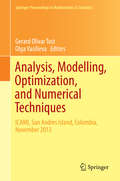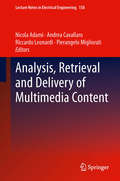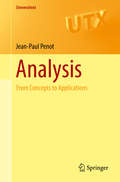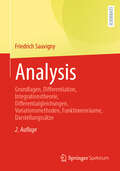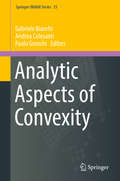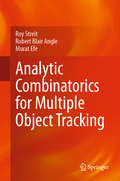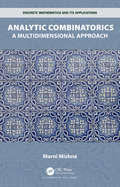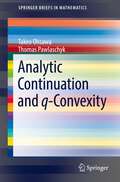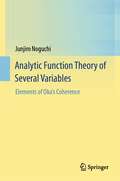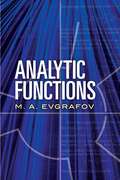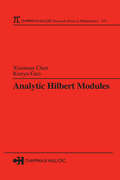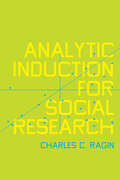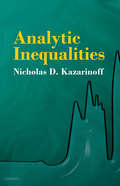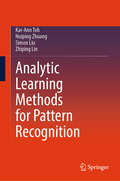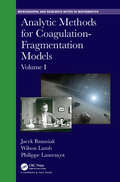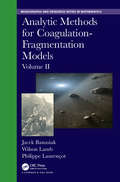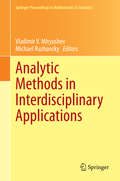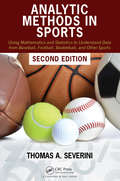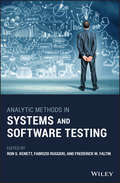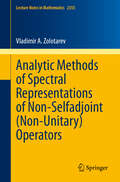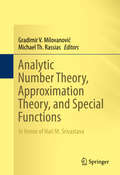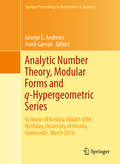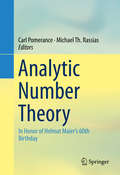- Table View
- List View
Analysis, Modelling, Optimization, and Numerical Techniques: ICAMI, San Andres Island, Colombia, November 2013 (Springer Proceedings in Mathematics & Statistics #121)
by Gerard Olivar Tost Olga VasilievaThis book highlights recent compelling research results and trends in various aspects of contemporary mathematics, emphasizing applicabilitions to real-world situations. The chapters present exciting new findings and developments in situations where mathematical rigor is combined with common sense. A multi-disciplinary approach, both within each chapter and in the volume as a whole, leads to practical insights that may result in a more synthetic understanding of specific global issues as well as their possible solutions. The volume will be of interest not only to experts in mathematics, but also to graduate students, scientists, and practitioners from other fields including physics, biology, geology, management, and medicine.
Analysis, Retrieval and Delivery of Multimedia Content (Lecture Notes in Electrical Engineering #158)
by Andrea Cavallaro Pierangelo Migliorati Nicola Adami Riccardo LeonardiCovering some of the most cutting-edge research on the delivery and retrieval of interactive multimedia content, this volume of specially chosen contributions provides the most updated perspective on one of the hottest contemporary topics. The material represents extended versions of papers presented at the 11th International Workshop on Image Analysis for Multimedia Interactive Services, a vital international forum on this fast-moving field. Logically organized in discrete sections that approach the subject from its various angles, the content deals in turn with content analysis, motion and activity analysis, high-level descriptors and video retrieval, 3-D and multi-view, and multimedia delivery. The chapters cover the finest detail of emerging techniques such as the use of high-level audio information in improving scene segmentation and the use of subjective logic for forensic visual surveillance. On content delivery, the book examines both images and video, focusing on key subjects including an efficient pre-fetching strategy for JPEG 2000 image sequences. Further contributions look at new methodologies for simultaneous block reconstruction and provide a trellis-based algorithm for faster motion-vector decision making.
Analysis: From Concepts to Applications (Universitext)
by Jean-Paul PenotThis textbook covers the main results and methods of real analysis in a single volume. Taking a progressive approach to equations and transformations, this book starts with the very foundations of real analysis (set theory, order, convergence, and measure theory) before presenting powerful results that can be applied to concrete problems. In addition to classical results of functional analysis, differential calculus and integration, Analysis discusses topics such as convex analysis, dissipative operators and semigroups which are often absent from classical treatises. Acknowledging that analysis has significantly contributed to the understanding and development of the present world, the book further elaborates on techniques which pervade modern civilization, including wavelets in information theory, the Radon transform in medical imaging and partial differential equations in various mechanical and physical phenomena. Advanced undergraduate and graduate students, engineers as well as practitioners wishing to familiarise themselves with concepts and applications of analysis will find this book useful. With its content split into several topics of interest, the book's style and layout make it suitable for use in several courses, while its self-contained character makes it appropriate for self-study.
Analysis: Geometry, and Probability: Proceedings of the First Chilean Symposium of Mathematics
by Rolando ChuaquiThis volume contains versions of invited addresses and communications for the First Chilean Symposium of Mathematics, revealing the results of the mathematical advances in areas such as stochastic analysis, solutions of differential equations, and differential synthetic geometry and probability.
Analysis: Grundlagen, Differentiation, Integrationstheorie, Differentialgleichungen, Variationsmethoden, Funktionenräume, Darstellungssätze
by Friedrich SauvignyDieses Lehrbuch behandelt Lehrinhalte der Analysis für die ersten drei Semester des Bachelor-Studiums der Mathematik, Physik und Informatik. Es bietet eine moderne Darstellung der Differential- und Integralrechnung für Funktionen in einer und mehreren reellen sowie einer komplexen Variablen. Elementare Funktionen werden über komplexe Potenzreihen definiert und die Logarithmusfunktion auf ihrer Riemannschen Fläche betrachtet. Nachdem die eindimensionale Integration mittels reeller und komplexer Stammfunktionen durchgeführt ist, wird über uneigentliche n-dimensionale Riemannsche Integrale die Integration auf Mannigfaltigkeiten mit Differentialformen vorgestellt. Mit dem Lebesgueschen Integral und dessen Maßtheorie wird der Banachraum der p-fach integrablen Funktionen eingeführt. Für gewöhnliche Differentialgleichungen werden Existenz-, Eindeutigkeits- und Stabilitätsfragen beantwortet. In einem Kapitel zur Variationsrechnung wird über Geodätische der n-dimensionale Riemannsche Raum präsentiert. Ferner wird das Stieltjes-Integral mit BV-Belegungsfunktionen behandelt und die Differentiation absolut stetiger Funktionen durchgeführt. Schließlich wird der stetige Dualraum zum Lebesgueraum der p-fach integrablen Funktionen über den Rieszschen Darstellungssatz bestimmt.
Analytic Aspects of Convexity (Springer INdAM #25)
by Gabriele Bianchi Andrea Colesanti Paolo GronchiThis book presents the proceedings of the international conference Analytic Aspects in Convexity, which was held in Rome in October 2016. It offers a collection of selected articles, written by some of the world’s leading experts in the field of Convex Geometry, on recent developments in this area: theory of valuations; geometric inequalities; affine geometry; and curvature measures. The book will be of interest to a broad readership, from those involved in Convex Geometry, to those focusing on Functional Analysis, Harmonic Analysis, Differential Geometry, or PDEs. The book is a addressed to PhD students and researchers, interested in Convex Geometry and its links to analysis.
Analytic Combinatorics
by Philippe Flajolet Robert SedgewickAnalytic Combinatorics is a self-contained treatment of the mathematics underlying the analysis of discrete structures, which has emerged over the past several decades as an essential tool in the understanding of properties of computer programs and scientific models with applications in physics, biology and chemistry. Thorough treatment of a large number of classical applications is an essential aspect of the presentation. Written by the leaders in the field of analytic combinatorics, this text is certain to become the definitive reference on the topic. The text is complemented with exercises, examples, appendices and notes to aid understanding therefore, it can be used as the basis for an advanced undergraduate or a graduate course on the subject, or for self-study.
Analytic Combinatorics for Multiple Object Tracking
by Roy Streit Robert Blair Angle Murat EfeThe book shows that the analytic combinatorics (AC) method encodes the combinatorial problems of multiple object tracking—without information loss—into the derivatives of a generating function (GF). The book lays out an easy-to-follow path from theory to practice and includes salient AC application examples. Since GFs are not widely utilized amongst the tracking community, the book takes the reader from the basics of the subject to applications of theory starting from the simplest problem of single object tracking, and advancing chapter by chapter to more challenging multi-object tracking problems. Many established tracking filters (e.g., Bayes-Markov, PDA, JPDA, IPDA, JIPDA, CPHD, PHD, multi-Bernoulli, MBM, LMBM, and MHT) are derived in this manner with simplicity, economy, and considerable clarity. The AC method gives significant and fresh insights into the modeling assumptions of these filters and, thereby, also shows the potential utility of various approximation methods that are well established techniques in applied mathematics and physics, but are new to tracking. These unexplored possibilities are reviewed in the final chapter of the book.
Analytic Combinatorics: A Multidimensional Approach (Discrete Mathematics and Its Applications)
by Marni MishnaAnalytic Combinatorics: A Multidimensional Approach is written in a reader-friendly fashion to better facilitate the understanding of the subject. Naturally, it is a firm introduction to the concept of analytic combinatorics and is a valuable tool to help readers better understand the structure and large-scale behavior of discrete objects. Primarily, the textbook is a gateway to the interactions between complex analysis and combinatorics. The study will lead readers through connections to number theory, algebraic geometry, probability and formal language theory. The textbook starts by discussing objects that can be enumerated using generating functions, such as tree classes and lattice walks. It also introduces multivariate generating functions including the topics of the kernel method, and diagonal constructions. The second part explains methods of counting these objects, which involves deep mathematics coming from outside combinatorics, such as complex analysis and geometry. Features Written with combinatorics-centric exposition to illustrate advanced analytic techniques Each chapter includes problems, exercises, and reviews of the material discussed in them Includes a comprehensive glossary, as well as lists of figures and symbols About the author Marni Mishna is a professor of mathematics at Simon Fraser University in British Columbia. Her research investigates interactions between discrete structures and many diverse areas such as representation theory, functional equation theory, and algebraic geometry. Her specialty is the development of analytic tools to study the large-scale behavior of discrete objects.
Analytic Continuation and q-Convexity (SpringerBriefs in Mathematics)
by Takeo Ohsawa Thomas PawlaschykThe focus of this book is on the further development of the classical achievements in analysis of several complex variables, the analytic continuation and the analytic structure of sets, to settings in which the q-pseudoconvexity in the sense of Rothstein and the q-convexity in the sense of Grauert play a crucial role. After giving a brief survey of notions of generalized convexity and their most important results, the authors present recent statements on analytic continuation related to them. Rothstein (1955) first introduced q-pseudoconvexity using generalized Hartogs figures. Słodkowski (1986) defined q-pseudoconvex sets by means of the existence of exhaustion functions which are q-plurisubharmonic in the sense of Hunt and Murray (1978). Examples of q-pseudoconvex sets appear as complements of analytic sets. Here, the relation of the analytic structure of graphs of continuous surfaces whose complements are q-pseudoconvex is investigated. As an outcome, the authors generalize results by Hartogs (1909), Shcherbina (1993), and Chirka (2001) on the existence of foliations of pseudoconcave continuous real hypersurfaces by smooth complex ones. A similar generalization is obtained by a completely different approach using L²-methods in the setting of q-convex spaces. The notion of q-convexity was developed by Rothstein (1955) and Grauert (1959) and extended to q-convex spaces by Andreotti and Grauert (1962). Andreotti–Grauert's finiteness theorem was applied by Andreotti and Norguet (1966–1971) to extend Grauert's solution of the Levi problem to q-convex spaces. A consequence is that the sets of (q-1)-cycles of q-convex domains with smooth boundaries in projective algebraic manifolds, which are equipped with complex structures as open subsets of Chow varieties, are in fact holomorphically convex. Complements of analytic curves are studied, and the relation of q-convexity and cycle spaces is explained. Finally, results for q-convex domains in projective spaces are shown and the q-convexity in analytic families is investigated.
Analytic Function Theory of Several Variables: Elements of Oka’s Coherence
by Junjiro NoguchiThe purpose of this book is to present the classical analytic function theory of several variables as a standard subject in a course of mathematics after learning the elementary materials (sets, general topology, algebra, one complex variable). This includes the essential parts of Grauert–Remmert's two volumes, GL227(236) (Theory of Stein spaces) and GL265 (Coherent analytic sheaves) with a lowering of the level for novice graduate students (here, Grauert's direct image theorem is limited to the case of finite maps).The core of the theory is "Oka's Coherence", found and proved by Kiyoshi Oka. It is indispensable, not only in the study of complex analysis and complex geometry, but also in a large area of modern mathematics. In this book, just after an introductory chapter on holomorphic functions (Chap. 1), we prove Oka's First Coherence Theorem for holomorphic functions in Chap. 2. This defines a unique character of the book compared with other books on this subject, in which the notion of coherence appears much later.The present book, consisting of nine chapters, gives complete treatments of the following items: Coherence of sheaves of holomorphic functions (Chap. 2); Oka–Cartan's Fundamental Theorem (Chap. 4); Coherence of ideal sheaves of complex analytic subsets (Chap. 6); Coherence of the normalization sheaves of complex spaces (Chap. 6); Grauert's Finiteness Theorem (Chaps. 7, 8); Oka's Theorem for Riemann domains (Chap. 8). The theories of sheaf cohomology and domains of holomorphy are also presented (Chaps. 3, 5). Chapter 6 deals with the theory of complex analytic subsets. Chapter 8 is devoted to the applications of formerly obtained results, proving Cartan–Serre's Theorem and Kodaira's Embedding Theorem. In Chap. 9, we discuss the historical development of "Coherence".It is difficult to find a book at this level that treats all of the above subjects in a completely self-contained manner. In the present volume, a number of classical proofs are improved and simplified, so that the contents are easily accessible for beginning graduate students.
Analytic Functions (Dover Books on Mathematics)
by M.A. EvgrafovThis highly regarded text is directed toward advanced undergraduates and graduate students in mathematics who are interested in developing a firm foundation in the theory of functions of a complex variable. The treatment departs from traditional presentations in its early development of a rigorous discussion of the theory of multiple-valued analytic functions on the basis of analytic continuation. Thus it offers an early introduction of Riemann surfaces, conformal mapping, and the applications of residue theory. M. A. Evgrafov focuses on aspects of the theory that relate to modern research and assumes an acquaintance with the basics of mathematical analysis derived from a year of advanced calculus.Starting with an introductory chapter containing the fundamental results concerning limits, continuity, and integrals, the book addresses analytic functions and their properties, multiple-valued analytic functions, singular points and expansion in series, the Laplace transform, harmonic and subharmonic functions, extremal problems and distribution of values, and other subjects. Chapters are largely self-contained, making this volume equally suitable for the classroom or independent study.
Analytic Hilbert Modules (Chapman And Hall/crc Research Notes In Mathematics Ser. #433)
by Kunyu Guo Xiaoman ChenThe seminal 1989 work of Douglas and Paulsen on the theory of analytic Hilbert modules precipitated a number of major research efforts. This in turn led to some intriguing and valuable results, particularly in the areas of operator theory and functional analysis. With the field now beginning to blossom, the time has come to collect those results un
Analytic Induction for Social Research
by Charles C. RaginA free ebook version of this title is available through Luminos, University of California Press’s Open Access publishing program. Visit www.luminosoa.org to learn more. This book explores analytic induction, an approach to the analysis of cross-case evidence on qualitative outcomes that has deep roots in sociology. A popular research technique in the early decades of empirical sociology, analytic induction differs fundamentally as a method of social research from conventional variation-based approaches. In Analytic Induction for Social Research, Charles C. Ragin demonstrates that much is gained from systematizing analytic induction. The approach he introduces here offers a new template for conducting cross-case analysis and provides a new set of tools for answering common research questions that existing methods cannot address.
Analytic Inequalities
by Nicholas D. KazarinoffMathematical analysis is largely a systematic study and exploration of inequalities -- but for students the study of inequalities often remains a foreign country, difficult of access. This book is a passport to that country, offering a background on inequalities that will prepare undergraduates (and even high school students) to cope with the concepts of continuity, derivative, and integral.Beginning with explanations of the algebra of inequalities and conditional inequalities, the text introduces a pair of ancient theorems and their applications. Explorations of inequalities and calculus cover the number e, examples from the calculus, and approximations by polynomials. The final sections present modern theorems, including Bernstein's proof of the Weierstrass approximation theorem and the Cauchy, Bunyakovskii, Hölder, and Minkowski inequalities. Numerous figures, problems, and examples appear throughout the book, offering students an excellent foundation for further studies of calculus.
Analytic Learning Methods for Pattern Recognition
by Kar-Ann Toh Huiping Zhuang Simon Liu Zhiping LinThis textbook is a consolidation of learning methods which comes in an analytic form. The covered learning methods include classical and advanced solutions to problems of regression, minimum classification error, maximum receiver operating characteristics, bridge regression, ensemble learning and network learning. Both the primal and dual solution forms are discussed for over-and under-determined systems. Such coverage provides an important perspective for handling systems with overwhelming samples or systems with overwhelming parameters. For goal driven classification, the solutions to minimum classification-error, maximum receiver operating characteristics, bridge regression, and ensemble learning represent recent advancements in the literature. In this book, the exercises offer instructors and students practical experience with real-world applications.
Analytic Methods for Coagulation-Fragmentation Models, Volume I (Chapman & Hall/CRC Monographs and Research Notes in Mathematics)
by Jacek Banasiak Wilson Lamb Philippe LaurencotAnalytic Methods for Coagulation-Fragmentation Models is a two-volume set that provides a comprehensive exposition of the mathematical analysis of coagulation-fragmentation models. Initially, an in-depth survey of coagulation-fragmentation processes is presented, together with an account of relevant early results obtained on the associated model equations. These provide motivation for the subsequent detailed treatment of more up-to-date investigations which have led to significant theoretical developments on topics such as solvability and the long-term behaviour of solutions. To make the account as self-contained as possible, the mathematical tools that feature prominently in these modern treatments are introduced at appropriate places. The main theme of Volume I is the analysis of linear fragmentation models, with Volume II devoted to processes that involve the nonlinear contribution of coagulation. Features of Volume I: The main models of the theory together with their derivations and early methods of solution A detailed presentation of the operator theoretical methods and semigroup theory that play an essential role in the theory of fragmentation processes A comprehensive theory of fragmentation processes, including fragmentation with growth and decay in both the discrete and continuous particle size cases An analytical explanation of the `pathologies’ of the fragmentation equation, such as the shattering phase transition and non-uniqueness of solutions An analysis of the long-term dynamics of the discrete size fragmentation equation with growth
Analytic Methods for Coagulation-Fragmentation Models, Volume II (Chapman & Hall/CRC Monographs and Research Notes in Mathematics)
by Jacek Banasiak Wilson Lamb Philippe LaurencotAnalytic Methods for Coagulation-Fragmentation Models is a two-volume set that provides a comprehensive exposition of the mathematical analysis of coagulation-fragmentation models. Initially, an in-depth survey of coagulation-fragmentation processes is presented, together with an account of relevant early results obtained on the associated model equations. These provide motivation for the subsequent detailed treatment of more up-to-date investigations which have led to significant theoretical developments on topics such as solvability and the long-term behaviour of solutions. To make the account as self-contained as possible, the mathematical tools that feature prominently in these modern treatments are introduced at appropriate places. The main theme of Volume I is the analysis of linear fragmentation models, with Volume II devoted to processes that involve the nonlinear contribution of coagulation. Features of Volume II: A primer on weak compactness in L 1 and dynamical systems A comprehensive theory of solvability of the coagulation-fragmentation equation by both the semigroup and weak compactness methods, including a thorough analysis of the gelation and shattering phenomena A detailed analysis of the long-term dynamics of the coagulation-fragmentation equations with a state-of-the-art discussion on self-similar solutions
Analytic Methods in Interdisciplinary Applications (Springer Proceedings in Mathematics & Statistics #116)
by Michael Ruzhansky Vladimir V. MityushevThe book includes lectures given by the plenary and key speakers at the 9th International ISAAC Congress held 2013 in Krakow, Poland. The contributions treat recent developments in analysis and surrounding areas, concerning topics from the theory of partial differential equations, function spaces, scattering, probability theory, and others, as well as applications to biomathematics, queueing models, fractured porous media and geomechanics.
Analytic Methods in Sports: Using Mathematics and Statistics to Understand Data from Baseball, Football, Basketball, and Other Sports
by Thomas A. SeveriniOne of the greatest changes in the sports world in the past 20 years has been the use of mathematical methods to analyze performances, recognize trends and patterns, and predict results. Analytic Methods in Sports: Using Mathematics and Statistics to Understand Data from Baseball, Football, Basketball, and Other Sports, Second Edition provides a concise yet thorough introduction to the analytic and statistical methods that are useful in studying sports. The book gives you all the tools necessary to answer key questions in sports analysis. It explains how to apply the methods to sports data and interpret the results, demonstrating that the analysis of sports data is often different from standard statistical analyses. The book integrates a large number of motivating sports examples throughout and offers guidance on computation and suggestions for further reading in each chapter. Features Covers numerous statistical procedures for analyzing data based on sports results Presents fundamental methods for describing and summarizing data Describes aspects of probability theory and basic statistical concepts that are necessary to understand and deal with the randomness inherent in sports data Explains the statistical reasoning underlying the methods Illustrates the methods using real data drawn from a wide variety of sports Offers many of the datasets on the author’s website, enabling you to replicate the analyses or conduct related analyses New to the Second Edition R code included for all calculations A new chapter discussing several more advanced methods, such as binary response models, random effects, multilevel models, spline methods, and principal components analysis, and more Exercises added to the end of each chapter, to enable use for courses and self-study Full solutions manual available to course instructors.
Analytic Methods in Systems and Software Testing
by Fabrizio Ruggeri Ron S. Kenett Frederick W. FaltinA comprehensive treatment of systems and software testing using state of the art methods and tools This book provides valuable insights into state of the art software testing methods and explains, with examples, the statistical and analytic methods used in this field. Numerous examples are used to provide understanding in applying these methods to real-world problems. Leading authorities in applied statistics, computer science, and software engineering present state-of-the-art methods addressing challenges faced by practitioners and researchers involved in system and software testing. Methods include: machine learning, Bayesian methods, graphical models, experimental design, generalized regression, and reliability modeling. Analytic Methods in Systems and Software Testing presents its comprehensive collection of methods in four parts: Part I: Testing Concepts and Methods; Part II: Statistical Models; Part III: Testing Infrastructures; and Part IV: Testing Applications. It seeks to maintain a focus on analytic methods, while at the same time offering a contextual landscape of modern engineering, in order to introduce related statistical and probabilistic models used in this domain. This makes the book an incredibly useful tool, offering interesting insights on challenges in the field for researchers and practitioners alike. Compiles cutting-edge methods and examples of analytical approaches to systems and software testing from leading authorities in applied statistics, computer science, and software engineering Combines methods and examples focused on the analytic aspects of systems and software testing Covers logistic regression, machine learning, Bayesian methods, graphical models, experimental design, generalized regression, and reliability models Written by leading researchers and practitioners in the field, from diverse backgrounds including research, business, government, and consulting Stimulates research at the theoretical and practical level Analytic Methods in Systems and Software Testing is an excellent advanced reference directed toward industrial and academic readers whose work in systems and software development approaches or surpasses existing frontiers of testing and validation procedures. It will also be valuable to post-graduate students in computer science and mathematics.
Analytic Methods of Spectral Representations of Non-Selfadjoint (Lecture Notes in Mathematics #2355)
by Vladimir A. ZolotarevThis book is concerned with the theory of model representations of linear non-selfadjoint and non-unitary operators. This booming area of functional analysis owes its origins to the fundamental works of M. S. Livšic on the theory of characteristic functions, the deep studies of B. S.-Nagy and C. Foias on dilation theory, and also to the Lax–Phillips scattering theory. Here, a uniform conceptual approach is developed which organically unites all these theories. New analytic methods are introduced which make it possible to solve some important problems from the theory of spectral representations. Aimed at specialists in functional analysis, the book will also be accessible to senior mathematics students.
Analytic Number Theory, Approximation Theory, and Special Functions: In Honor of Hari M. Srivastava
by Michael Th. Rassias Gradimir V. MilovanovićThis book, in honor of Hari M. Srivastava, discusses essential developments in mathematical research in a variety of problems. It contains thirty-five articles, written by eminent scientists from the international mathematical community, including both research and survey works. Subjects covered include analytic number theory, combinatorics, special sequences of numbers and polynomials, analytic inequalities and applications, approximation of functions and quadratures, orthogonality and special and complex functions. The mathematical results and open problems discussed in this book are presented in a simple and self-contained manner. The book contains an overview of old and new results, methods, and theories toward the solution of longstanding problems in a wide scientific field, as well as new results in rapidly progressing areas of research. The book will be useful for researchers and graduate students in the fields of mathematics, physics and other computational and applied sciences.
Analytic Number Theory, Modular Forms and q-Hypergeometric Series: In Honor of Krishna Alladi's 60th Birthday, University of Florida, Gainesville, March 2016 (Springer Proceedings in Mathematics & Statistics #221)
by George E. Andrews Frank GarvanGathered from the 2016 Gainesville Number Theory Conference honoring Krishna Alladi on his 60th birthday, these proceedings present recent research in number theory. Extensive and detailed, this volume features 40 articles by leading researchers on topics in analytic number theory, probabilistic number theory, irrationality and transcendence, Diophantine analysis, partitions, basic hypergeometric series, and modular forms. Readers will also find detailed discussions of several aspects of the path-breaking work of Srinivasa Ramanujan and its influence on current research. Many of the papers were motivated by Alladi's own research on partitions and q-series as well as his earlier work in number theory. <P><P> Alladi is well known for his contributions in number theory and mathematics. His research interests include combinatorics, discrete mathematics, sieve methods, probabilistic and analytic number theory, Diophantine approximations, partitions and q-series identities. Graduate students and researchers will find this volume a valuable resource on new developments in various aspects of number theory.
Analytic Number Theory: In Honor of Helmut Maier’s 60th Birthday
by Michael Th. Rassias Carl PomeranceThis volume contains a collection of research and survey papers written by some of the most eminent mathematicians in the international community and is dedicated to Helmut Maier, whose own research has been groundbreaking and deeply influential to the field. Specific emphasis is given to topics regarding exponential and trigonometric sums and their behavior in short intervals, anatomy of integers and cyclotomic polynomials, small gaps in sequences of sifted prime numbers, oscillation theorems for primes in arithmetic progressions, inequalities related to the distribution of primes in short intervals, the Möbius function, Euler's totient function, the Riemann zeta function and the Riemann Hypothesis. Graduate students, research mathematicians, as well as computer scientists and engineers who are interested in pure and interdisciplinary research, will find this volume a useful resource. Contributors to this volume: Bill Allombert, Levent Alpoge, Nadine Amersi, Yuri Bilu, Régis de la Bretèche, Christian Elsholtz, John B. Friedlander, Kevin Ford, Daniel A. Goldston, Steven M. Gonek, Andrew Granville, Adam J. Harper, Glyn Harman, D. R. Heath-Brown, Aleksandar Ivi, Geoffrey Iyer, Jerzy Kaczorowski, Daniel M. Kane, Sergei Konyagin, Dimitris Koukoulopoulos, Michel L. Lapidus, Oleg Lazarev, Andrew H. Ledoan, Robert J. Lemke Oliver, Florian Luca, James Maynard, Steven J. Miller, Hugh L. Montgomery, Melvyn B. Nathanson, Ashkan Nikeghbali, Alberto Perelli, Amalia Pizarro-Madariaga, János Pintz, Paul Pollack, Carl Pomerance, Michael Th. Rassias, Maksym Radziwi, Joël Rivat, András Sárközy, Jeffrey Shallit, Terence Tao, Gérald Tenenbaum, László Tóth, Tamar Ziegler, Liyang Zhang.
